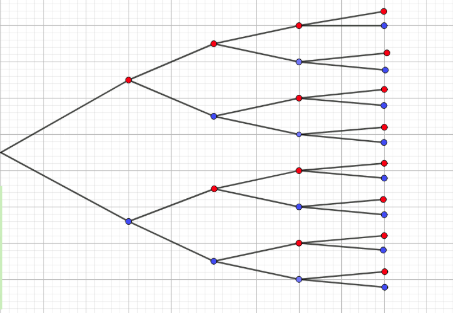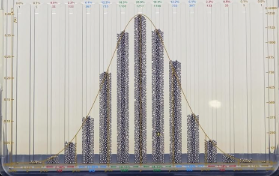Distributions
It is highly recommended to read Probability beforehand.
Binomial Distribution
This section handles the instance where a choice between two options has to be made. We can visualise it as a probability tree

Suppose there is an equal probability to get a red or blue ball. What is the probability that red has been picked at least 2 times.
There are 4C4 ways to pick 4 reds, 4C3 to pick 3 and 4C2 ways to pick 2. The total number of possible outcomes is also
If the probability of getting a red ball is
The probability of traversing down a single path on the tree with 2 red balls is
Thus we say that R follows a binomial distribution.
If you were to plot

Above shows a binomial distribution where
A Galton board consist of a narrow opening at the top which allows holes to fall through a series of pins before dropping into a bin at the bottom. Can you explain what distribution the balls will follow and why?

Ans:
For a ball to fall into pocket J, it chooses to move left or right 8 times. The number of times it moved left is 5 times, and right is 3 times. Since there is an equal possibility of moving left or right,
Thus, there are 8C5 paths that reaches pocket J. And the probability of each individual path is
Extending this to all the other pockets. where
We see that this

Normal Distribution
Central Limit Theorem
The CLT states that the summation of independent random processes always follow a Normal distribution. Binomial distribution is just a variant of a Normal distribution.
where
The probability of observing X is given as
The Gaussian Distribution is given as
But for the sake of our sanity, lets just ignore all this and reduce the formula to the below. Basically all normal distributions are usually in this form
Do you know that the expression below simply cannot be defined using known identities? (No arrangement of
But Mathematicians were able to figure out that (proof) Its a really beautiful proof (Go check it out)